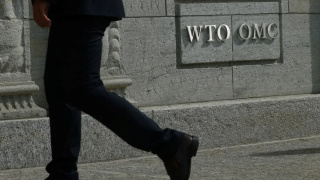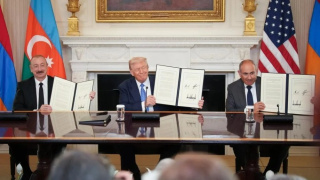Will China Ever Go to War Over Taiwan? What Role Will ASEAN and the Quad Play?
They say practice makes perfect, especially for smaller things in life like playing a musical instrument or learning a new language. But what about fighting wars? Does practice make you perfect at fighting wars?
China certainly thinks so. Satellite images have revealed their so called practice rangers. There are satellite images that reveal the location of missiles located deep in a desert in Xinjiang. The layout is interesting. It resembled a naval base with a warship, not a Chinese naval base, but a Taiwanese naval base. Experts have identified the similarities. China’s practice rage resembles a base in northeast Taiwan. If war breaks out, this base would be crucial.
So what does China do? Practice missile strikes on replicas. When I say replicas, they are pretty spot-on. The pier, the warships, everything is built to specification. Reports say this was made in December of 2020. Once completed, China’s PLA (People’s Liberation Army) blew it up with a missile strike like a dress rehearsal before the real deal. And it’s not just Taiwan. Replicas have been spotted of US bases in Japan and Guam. So is China is readying for a wider war? The question is, will they put their practice into motion? They certainly have the tools. China is known to have developed two hypersonic missiles. One is called, the “Carrier Killer”. The other is called the “Guam Killer”. You can imagine why. The second missile has a range of 5,000 kilometers. In another words, enough to hit the US military base in Guam.
If this is not war posturing, what is? China is replicating Taiwanese bases in their deserts, the pier, the ship, everything. These replicas are being torn to smithereens by the PLA. How is this not an escalation? It clearly means China is thinking about war. I have more evidence for you.
Another satellite picture resembles a Chinese ship yard. In this picture there is a blue object that resembles a submarine, possibly a nuclear powered one. Intelligence reports have repeatedly warned of this that China is developing a new class of submarines and this could be it! More range, more reliability and more protection for Chinese warships. Clearly, the dragon is eying the high seas.
How is the quad alliance of India-US-Japan-Australia, better known as the Quadrilateral Security Dialogue, supposed to respond? In response to these Chinese advancements, eight months ago, an important meeting took place in Washington DC: The ASEAN summit. ASEAN stands for “Association of Southeast Asian Nations”. They are a big trading block. An economic powerhouse! They are a political and economic union of 10 member states in Southeast Asia, which promotes intergovernmental cooperation and facilitates economic, political, security, military, educational, and sociocultural integration between its members and other countries in the Asia-Pacific.
The union has a total area of 4,522,518 km2 (1,746,154 square miles) and an estimated total population of about 668 million! Most importantly, they have differences with China. Joe Biden is looking to exploit these differences. The summit kicked off with a dinner at the White House. Eight ASEAN heads of state were in attendance. Myanmar was excluded because of their military coup. The Philippines was also absent because at that time, they didn’t have a president in charge. The big headline was this: Biden announced a $150 million package to ASEAN. It was a good start. But as always, Washington was late. In November of 2021, China too announced a package for ASEAN. Guess how much it was? $1.5 billion!
That’s the biggest challenge for the US because the ASEAN states (Brunei, Cambodia, Indonesia, Laos, Malaysia, Myanmar, the Philippines, Singapore, Thailand, and Vietnam) are no fans of China. Most of them have territorial disputes with Beijing at the same time, they have no choice but to engage. China is ASEAN’s biggest trade partner. Their total trade is worth around $274 billion. Europe is second. America is third. And Beijing knows about these dependencies and how to accommodate as well as exploit it.
In a Global Times article from July 24, 2021, it was noted that the industry supply chain of China and ASEAN is closely connected, thanks to institutional arrangements like the China-ASEAN trade area. The US lacks a global program equivalent to the Chinese’ open and inclusive belt and road initiative.
Ignore the joke about “inclusive” BRI, other than that, China has a point. ASEAN’s economy is too dependent on China’s, plus there’s little military deterrence. Western warships make occasional voyages through the South China Sea. But that’s not slowing or stopping China. Their warships continue to challenge ASEAN states.
So Joe Biden needs a two-part plan. The first plan must focus on alternatives to belt and road, alternatives to Chinese supply chain, alternatives to Chinese loans that basically have created Southeast Asia to Chinese dependency. The second plan’s focus must be on defense. ASEAN states must be capable of defending against the PLA. That’s where partners like India come in. The Philippines, for example, bought the BrahMos missiles from India. The BrahMos is a medium-range stealth ramjet supersonic cruise missile that can be launched from submarine, ships, airplanes or land, notably being the fastest supersonic cruise missile in the world at the time of introducing. Even now, it is claimed to be the fastest anti-ship cruise missile currently in operation. It is a joint-venture between the India and Russia. The name “BrahMos” is a portmanteau formed from the names of two rivers, the Brahmaputra River of India and the Moskva River of Russia.
Reports say Vietnam is also interested in these BrahMos missiles. So America must take on a different role in the Indo-Pacific, not like the one they played in Europe. Unquestioned leadership will not work here. The US must work as an equal partner. Something Washington has not been used to. This superiority complex is in fact US’s Achilles heel in the greater and wider world outside that meat grinder called the Middle East.











